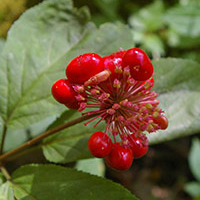American Ginseng
Scientific name: Panax quinquefolius

Cover photo credit: Rob Tervo
Status
Threatened
Threatened
means the species lives in the wild in Ontario, is not endangered, but is likely to become endangered if steps are not taken to address factors threatening it.
Date added to the Species at Risk in Ontario List
The American Ginseng was already assessed as at risk when the Endangered Species Act, 2007 took effect in 2008.
Read the most recent assessment report [PDF]
What it looks like
American Ginseng is a perennial herb that grows up to 60 centimetres tall. Individual plants take several years to reach reproductive maturity.
The root of this plant resembles a gnarly parsnip. The single stem ends in a whorl of one to four or occasionally five leaves.
Each leaf typically has five leaflets radiating from a central point at the end of the leaf stem.
Mature plants have an erect stem originating from the top of the main stem, at the center of the whorl of leaves, with a cluster of six to 20 inconspicuous greenish-white flowers. The fruit consists of fleshy, bright-red berries in a semi-spherical cluster.
Where it lives
In Ontario, American Ginseng typically grows in relatively mature, deciduous woods dominated by Sugar Maple (Acer saccharum), White Ash (Fraxinus americana) and American Basswood (Tilia americana).
It usually grows in deep, moist, but well drained nutrient-rich soil over limestone or marble bedrock.
In the United States, American Ginseng ranges from Louisiana and Georgia and north to New England and Minnesota.
Where it’s been found in Ontario
Wild populations of American Ginseng are found in southern Ontario.
What threatens it
Small population sizes make American Ginseng especially susceptible to human-caused or natural disturbances of its habitat such as:
- habitat loss, degradation and fragmentation
- deforestation and forest harvesting
- increased recreational activities in or around habitat
- illegal harvesting for commercial purposes
Invasive and non-invasive species also pose a direct threat (for example, browsing and predation by white-tailed deer and consumption of seeds by small mammals).
The following invasive plants species compete with American Ginseng for resources:
- Garlic Mustard (Alliaria petiolata)
- Dog-strangling Vine (Cynanchum rossicum)
- Common Buckthorn (also known as European Buckthorn) (Rhamnus cathartica)
Action we are taking
This species and its habitat are protected under Ontario’s Endangered Species Act, 2007 (ESA).
The ESA also requires us to prepare recovery guidance for threatened species such as American Ginseng.
All species listed on the Species at Risk in Ontario List may be eligible for consideration for government funding through the Species at Risk Stewardship Program.
Recovery strategy and other plans
A recovery strategy advises the ministry on ways to ensure healthy numbers of the species return to Ontario.
Read the executive summary and the full document (July 22, 2019)
Government response statement
A government response statement outlines the actions the government intends to take or support to help recover the species.
Read the government response statement (April 23, 2020)
Habitat protection
General habitat descriptions are technical, science-based documents that provide greater clarity on the area of habitat protected for a species.
Read the general habitat description (July 2, 2013)
What you can do
Report a sighting
Submit your observations of species at risk to the Natural Heritage Information Centre (NHIC), which is Ontario’s conservation data centre. Join the “(NHIC) Rare Species of Ontario” project in iNaturalist to make submitting your observations quick and easy.
Volunteer
Volunteer with your local nature club or provincial park to participate in surveys or stewardship work focused on species at risk.
Be a good steward
Private landowners have a very important role to play in species recovery. If you find species at risk on your land, you may be eligible for stewardship programs that support the protection and recovery of species at risk and their habitats. Learn more about the Species at Risk Stewardship Program.
Invasive species seriously threaten many of Ontario’s species at risk. To learn what you can do to help reduce the threat of invasive species, visit:
- Invasive species in Ontario
- Ontario's Invading Species Awareness Program
- Ontario Invasive Plant Council
Report illegal activity
Report any illegal activity related to plants and wildlife to
Quick facts
- Indigenous peoples have used American Ginseng for a wide range of medicinal purposes including treatment of headaches, earaches, rheumatism, convulsions, bleeding, fevers, vomiting, tuberculosis, gonorrhea and as a cure-all when other treatments failed.
- In Asia, the root of the closely related Asian Ginseng (Panax ginseng) has been used in traditional medicine for thousands of years.